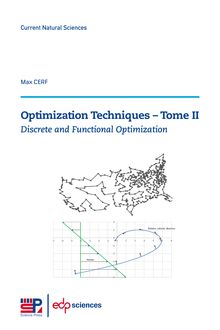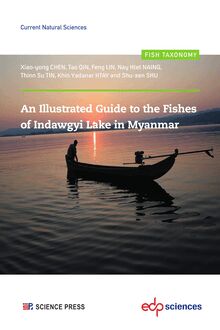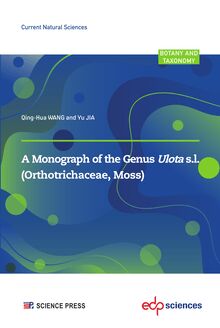-
 Univers
Univers
-
 Ebooks
Ebooks
-
 Livres audio
Livres audio
-
 Presse
Presse
-
 Podcasts
Podcasts
-
 BD
BD
-
 Documents
Documents
-
- Cours
- Révisions
- Ressources pédagogiques
- Sciences de l’éducation
- Manuels scolaires
- Langues
- Travaux de classe
- Annales de BEP
- Etudes supérieures
- Maternelle et primaire
- Fiches de lecture
- Orientation scolaire
- Méthodologie
- Corrigés de devoir
- Annales d’examens et concours
- Annales du bac
- Annales du brevet
- Rapports de stage
La lecture à portée de main
Découvre YouScribe en t'inscrivant gratuitement
Je m'inscrisDécouvre YouScribe en t'inscrivant gratuitement
Je m'inscrisEn savoir plus
En savoir plus

Description
Le livre ‘The Chinese Botanical Gardens’ résume de manière exhaustive le développement historique, la distribution et la subordination, l'introduction et la collecte des plantes, la conservation ex situ, l'enregistrement des informations sur les plantes, la recherche scientifique et l'état d'utilisation des jardins botaniques en Chine, avec une présentation détaillée du développement et de la conservation de 161jardins botaniques en Chine. Les jardins botaniques chinois ont joué un rôle actif dans la protection, l'exploration et l'utilisation des plantes et ont apporté un soutien important à la recherche botanique. Ils sont devenus une attraction touristique de grande qualité et une base d'éducation scientifique populaire en Chine.
Ce livre fournira des informations de base sur la construction, la gestion et le développement des jardins botaniques chinois. Il peut être utilisé comme matériel de recherche et de référence pour les enseignants et les étudiants professionnels concernés, les institutions d'éducation scientifique et les agences de voyage. Il peut également servir de référence pour la coopération entre les jardins botaniques chinois et étrangers.
Contents v
Preface
Chapter 1 Outline of the Chinese Botanical Gardens.....................................................................1
Chapter 2 A Brief Introduction of Botanical Gardens of China ................................................23
Beijing
Beijing Botanical Garden of Institute of Botany, Chinese Academy of Sciences......24
Beijing Botanical Garden.............................................................................................27
Beijing Medicinal Botanical Garden............................................................................30
Beijing Teaching Botanical Garden.............................................................................32
Shanghai
Medicinal Botanical Garden of the Second Military Medical University..................34
Shanghai Botanical Garden..........................................................................................36
Shanghai Chenshan Botanical Garden, Chinese Academy of Sciences......................38
Chongqing
Chongqing Medicinal Botanical Garden.....................................................................41
Nanshan Botanical Garden...........................................................................................43
Chongqing Botanical Garden.......................................................................................45
Botanical Garden of Chongqing University................................................................47
Anhui
Huangshan Arboretum of Anhui Academy of Forestry...............................................50
Hefei Botanical Garden................................................................................................52
Fujian
Fuzhou Botanical Garden.............................................................................................54
Xiamen Overseas Chinese Subtropical Plant Introduction Garden.............................56
Contents
vi THE CHINESE BOTANICAL GARDENS
Xiamen Botanical Garden............................................................................................58
Teaching Botanical Garden of Fujian Agriculture and Forestry University...............60
Gansu
Minqin Desert Botanical Garden.................................................................................62
Maiji Botanical Garden................................................................................................65
Lanzhou Arboretum......................................................................................................67
Lanzhou Botanical Garden...........................................................................................69
Guangdong
South China Botanical Garden, Chinese Academy of Sciences..................................72
South Subtropical Botanical Garden............................................................................76
Dinghushan Arboretum of South China Botanical Garden, Chinese Academy of
Sciences........................................................................................................................78
Guangdong Tree Park...................................................................................................81
Arboretum of South China Agricultural University....................................................83
Shenzhen Fairylake Botanical Garden, Chinese Academy of Sciences......................85
Dongguan Botanical Garden........................................................................................87
Zhongshan Arboretum..................................................................................................89
Medicinal Botanical Garden of Guangdong Pharmaceutical University....................91
Chaozhou Botanical Garden.........................................................................................93
Guangxi
Arboretum of Guangxi Academy of Forestry..............................................................95
Guilin Botanical Garden of Guangxi Institute of Botany, Chinese Academy of
Sciences........................................................................................................................97
Guangxi Medicinal Botanical Garden........................................................................100
Arboretum of Experimental Center of Tropical Forestry, Chinese Academy of
Forestry.......................................................................................................................103
Nanning Arboretum....................................................................................................105
Qingxiushan Forestry Botanical Garden....................................................................107
Liuzhou Karst Botanical Garden................................................................................110
Guizhou
Guizhou Botanical Garden.........................................................................................113
Arboretum of Guizhou Academy of Forestry............................................................115
Guiyang Medicinal Botanical Garden........................................................................117
Contents vii
Rare and Plateau Botanical Garden of Guizhou Mid-Subtropics..............................119
Zunyi Botanical Garden.............................................................................................121
Arboretum of Dongfeng Forestry Farm.....................................................................123
Hainan
Xinglong Tropical Botanical Garden.........................................................................125
Hainan Tropical Botanical Garden.............................................................................128
Hainan Fengmu Arboretum........................................................................................130
Xinglong Tropical Medicinal Botanical Garden........................................................132
Tropical Arboretum at Jianfengling...........................................................................134
Xinglong Tropical Garden..........................................................................................136
Hebei
Shijiazhuang Botanical Garden..................................................................................140
Gaobeidian Botanical Garden....................................................................................142
Baoding Botanical Garden.........................................................................................144
Tangshan Botanical Garden........................................................................................146
Henan
Jigongshan Botanical Garden.....................................................................................148
Luoyang National Peony Garden...............................................................................151
Zhengzhou Huanghe Botanical Garden.....................................................................153
Luoyang International Peony Garden........................................................................155
China National Flower Garden..................................................................................157
Luoyang Sui and Tang Relics Botanical Garden.......................................................159
Zhengzhou Botanical Garden.....................................................................................162
Heilongjiang
Heilongjiang Forest Botanical Garden.......................................................................164
Xiaoxinganling Botanical Garden..............................................................................166
Jixi Zoological and Botanical Garden........................................................................168
Jinhewan Wetland Botanical Garden.........................................................................170
Hubei
Wuhan Botanical Garden, Chinese Academy of Sciences........................................172
Moshan Landscape Botanical Garden........................................................................175
Central China Medicinal Botanical Garden...............................................................178
viii THE CHINESE BOTANICAL GARDENS
Yichang Sanxia Botanical Garden.............................................................................180
Hunan
Hunan Nanyue Arboretum.........................................................................................182
Hunan Forest Botanical Garden.................................................................................184
Chenzhou Nanling Botanical Garden........................................................................186
Arboretum of South Central Forestry Science and Technology University..............188
South Hunan Botanical Garden..................................................................................190
Guidong Botanical Garden.........................................................................................192
Jilin
Changbaishan Botanical Garden................................................................................194
Changchun Forest Botanical Garden.........................................................................196
Changchun Zoological and Botanical Garden...........................................................198
Jiangsu
Nanjing Botanical Garden Mem. Sun Yat-sen, Chinese Academy of Sciences........200
Pharmaceutical Arboretum of China Pharmaceutical University..............................203
Taihu Ornamental Botanical Garden..........................................................................205
Xuzhou Botanical Garden..........................................................................................208
Yangzhou Botanical Garden.......................................................................................210
Chongchuan Botanical Garden..................................................................................213
Jiangxi
Lushan Botanical Garden, Chinese Academy of Sciences........................................216
Gannan Arboretum.....................................................................................................219
Dagangshan Arboretum..............................................................................................222
Nanchang Botanical Garden.......................................................................................224
Liaoning
Xiongyue Arboretum..................................................................................................226
Shenyang Arboretum of Institute of Applied Ecology, Chinese Academy of Sciences.
.....................................................................................................................................228
Medicinal Botanical Garden of Shenyang Pharmaceutical University.....................231
Shenyang Botanical Garden.......................................................................................233
Dalian Botanical Garden............................................................................................236
Dalian Yinggeshi Botanical Garden...........................................................................238
Contents ix
Shenyang Tree Specimens Garden.............................................................................241
Inner Mongolia
Arding Botanical Garden............................................................................................245
Arboretum of the Inner Mongolia Academy of Forestry...........................................248
Chifeng Botanical Garden..........................................................................................250
Ningxia
Yinchuan Botanical Garden.......................................................................................252
Qinghai
Xining Landscape Botanical Garden.........................................................................254
Shandong
Arboretum of Shandong Agricultural University......................................................257
Botanical Garden of Shandong College of Traditional Chinese Medicine...............259
Qingdao Botanical Garden.........................................................................................261
Shandong Linyi Zoological and Botanical Garden...................................................263
Jinan Botanical Garden...............................................................................................265
Weifang Botanical Garden.........................................................................................267
Forest Botanical Garden of Taishan Forestry Research Institute..............................270
Herb Garden of Shandong University of Traditional Chinese Medicine..................272
Shanxi
Wutaishan Arboretum.................................................................................................274
Datong Botanical Garden...........................................................................................276
Jinsha Botanical Garden.............................................................................................278
Taiyuan Botanical Garden..........................................................................................281
Shaanxi
Yulin Hongshixia Sand Botanical Garden.................................................................283
Xi’an Botanical Garden..............................................................................................285
Baoji Botanical Garden..............................................................................................288
Northwest Agriculture and Forestry University Arboretum......................................290
Heilongtan Montane Arboretum................................................................................292
Yulin Woyunshan Botanical Garden..........................................................................294
Qinling National Botanical Garden, Chinese Academy of Sciences........................296
x THE CHINESE BOTANICAL GARDENS
Sichuan
Chengdu Botanical Garden........................................................................................298
Emeishan Botanical Garden.......................................................................................300
West China Subalpine Botanical Garden of Institute of Botany, Chinese Academy of
Sciences......................................................................................................................303
Xinjiang
Turpan Desert Botanical Garden, Chinese Academy of Sciences.............................305
Urumqi Botanical Garden..........................................................................................308
Tazhong Botanical Garden.........................................................................................311
Botanical Garden of Longkun....................................................................................313
Yunnan
Kunming Botanical Garden of Kunming Institute of Botany, Chinese Academy of
Sciences......................................................................................................................315
Xishuangbanna Tropical Botanical Garden, Chinese Academy of Sciences............318
Xishuangbanna Medicinal Botanical Garden............................................................321
Kunming Arboretum of Yunnan Academy of Forestry..............................................323
Kunming Landscape Botanical Garden.....................................................................325
Xishuangbanna Tropical Flower Garden...................................................................327
Shangri-La Alpine Botanical Garden.........................................................................329
Zhejiang
The Botanical Garden of Zhejiang University...........................................................332
Hangzhou Botanical Garden......................................................................................334
Wenzhou Botanical Garden........................................................................................336
Anji Bamboo Garden..................................................................................................338
Zhejiang Bamboo Garden..........................................................................................341
Introduction and Domestication Botanical Garden of Zhoushan Island...................343
Botanical Garden of Zhejiang Agriculture and Forestry University.........................345
Tianjing Aquatic Botanical Garden............................................................................348
Jiaxing Botanical Garden...........................................................................................350
Tongxiang Botanical Garden......................................................................................352
Ningbo Botanical Garden...........................................................................................354
Hong Kong
Hong Kong Zoological and Botanical Gardens.........................................................357
Contents xi
Kadoorie Farm & Botanic Garden.............................................................................359
Shing Mun Arboretum................................................................................................362
Macao
Macao Botanical Garden............................................................................................365
Taiwan
Taipei Botanical Garden.............................................................................................368
Hengchun Tropical Botanical Garden........................................................................371
Chiayi Botanical Garden............................................................................................374
Taiwan Alpine Botanical Garden...............................................................................377
Siaping Tropical Botanical Garden............................................................................379
Shuangsi Tropical Arboretum.....................................................................................382
Fushan Botanical Garden...........................................................................................384
Shanping Forest Ecological Science Park..................................................................387
Kaohsiung Original Botanical Garden.......................................................................389
Neishuangxi Medicinal Herb Garden........................................................................391
Museum of Natural Science Botanical Garden..........................................................393
Yuan Sen Applied Botanical Garden..........................................................................396
Taimali Coastal Botanical Garden..............................................................................399
Chapter 3 Status Quo and Developmental Prospects of the Chinese Botanical Gardens......403
References............................................................................................................................................420
Sujets
Informations
| Publié par | EDP Sciences |
| Date de parution | 13 janvier 2022 |
| Nombre de lectures | 0 |
| EAN13 | 9782759827015 |
| Langue | English |
| Poids de l'ouvrage | 176 Mo |
Informations légales : prix de location à la page 1,7800€. Cette information est donnée uniquement à titre indicatif conformément à la législation en vigueur.
Extrait
-
 Univers
Univers
-
 Ebooks
Ebooks
-
 Livres audio
Livres audio
-
 Presse
Presse
-
 Podcasts
Podcasts
-
 BD
BD
-
 Documents
Documents
-
Jeunesse
-
Littérature
-
Ressources professionnelles
-
Santé et bien-être
-
Savoirs
-
Education
-
Loisirs et hobbies
-
Art, musique et cinéma
-
Actualité et débat de société
-
Jeunesse
-
Littérature
-
Ressources professionnelles
-
Santé et bien-être
-
Savoirs
-
Education
-
Loisirs et hobbies
-
Art, musique et cinéma
-
Actualité et débat de société
-
Actualités
-
Lifestyle
-
Presse jeunesse
-
Presse professionnelle
-
Pratique
-
Presse sportive
-
Presse internationale
-
Culture & Médias
-
Action et Aventures
-
Science-fiction et Fantasy
-
Société
-
Jeunesse
-
Littérature
-
Ressources professionnelles
-
Santé et bien-être
-
Savoirs
-
Education
-
Loisirs et hobbies
-
Art, musique et cinéma
-
Actualité et débat de société
- Cours
- Révisions
- Ressources pédagogiques
- Sciences de l’éducation
- Manuels scolaires
- Langues
- Travaux de classe
- Annales de BEP
- Etudes supérieures
- Maternelle et primaire
- Fiches de lecture
- Orientation scolaire
- Méthodologie
- Corrigés de devoir
- Annales d’examens et concours
- Annales du bac
- Annales du brevet
- Rapports de stage




















